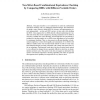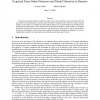184 search results - page 5 / 37 » Two New Criteria for Comparison in the Bruhat Order |
ANOR
2008
13 years 8 months ago
2008
In this paper, we consider several discrete-time priority queues with priority jumps. In a priority scheduling scheme with priority jumps, real-time and non-real-time packets arri...
FMCAD
2004
Springer
14 years 1 months ago
2004
Springer
This paper describes a new method that is useful in combinational equivalence checking with very challenging industrial designs. The method does not build a miter; instead it build...
GCB
2007
Springer
14 years 2 months ago
2007
Springer
The most parsimonous distances calculated in pairwise gene order comparisons cannot accurately reflect the true number of events separating two species, unless the number of chan...
ICSM
2007
IEEE
14 years 2 months ago
2007
IEEE
Test suite reduction seeks to reduce the number of test cases in a test suite while retaining a high percentage of the original suite’s fault detection effectiveness. Most appro...
SODA
2004
ACM
13 years 9 months ago
2004
ACM
The analyses of many algorithms and data structures (such as digital search trees) for searching and sorting are based on the representation of the keys involved as bit strings and...


